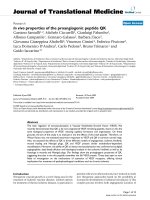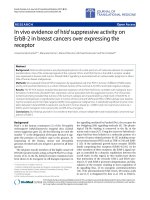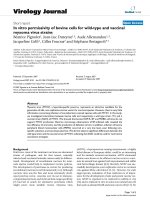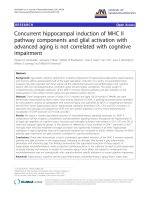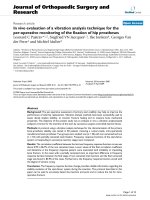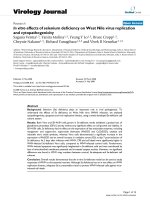Báo cáo hóa học: " In vitro permissivity of bovine cells for wild-type and vaccinal myxoma virus strains" potx
Bạn đang xem bản rút gọn của tài liệu. Xem và tải ngay bản đầy đủ của tài liệu tại đây (462.91 KB, 5 trang )
BioMed Central
Page 1 of 5
(page number not for citation purposes)
Virology Journal
Open Access
Short report
In vitro permissivity of bovine cells for wild-type and vaccinal
myxoma virus strains
Béatrice Pignolet
1
, Jean-Luc Duteyrat
1,3
, Aude Allemandou
1,3
,
Jacqueline Gelfi
1
, Gilles Foucras
2
and Stéphane Bertagnoli*
1
Address:
1
Laboratory « Interactions Hôtes-Virus et Vaccinologie », UMR 1225 INRA-ENVT, Ecole Nationale Vétérinaire de Toulouse, 23 chemin des
capelles, Toulouse F-31076, France,
2
laboratory « Résistome des ruminants », UMR 1225 INRA-ENVT, Ecole Nationale Vétérinaire de Toulouse, 23
chemin des capelles, Toulouse F-31076, France and
3
Centre de Microscopie Electronique Appliquée à la Biologie, Faculté de Médecine de Rangueil,
133 route de Narbonne, Toulouse, F-31062, France
Email: Béatrice Pignolet - ; Jean-Luc Duteyrat - ; Aude Allemandou - ;
Jacqueline Gelfi - ; Gilles Foucras - ; Stéphane Bertagnoli* -
* Corresponding author
Abstract
Myxoma virus (MYXV), a leporide-specific poxvirus, represents an attractive candidate for the
generation of safe, non-replicative vaccine vector for non-host species. However, there is very little
information concerning infection of non-laboratory animals species cells with MYXV. In this study,
we investigated interactions between bovine cells and respectively a wild type strain (T1) and a
vaccinal strain (SG33) of MYXV. We showed that bovine KOP-R, BT and MDBK cell lines do not
support MYXV production. Electron microscopy observations of BT-infected cells revealed the
low efficiency of viral entry and the production of defective virions. In addition, infection of bovine
peripheral blood mononuclear cells (PBMC) occurred at a very low level, even following non-
specific activation, and was always abortive. We did not observe significant differences between the
wild type strain and the vaccinal strain of MYXV, indicating that SG33 could be used for new bovine
vaccination strategies.
Background
Until now, most of the ruminant vaccines use attenuated
strains of pathogens, and for that reason, naturally
infected and vaccinated animals cannot easily be differen-
tiated. Development of recombinant vaccines for rumi-
nant species would help to implement vaccine policies.
The development of poxviruses as vectors for producing
recombinant vaccines is well documented [1-6]. Although
vaccinia virus was the first and most extensively devel-
oped poxvirus vector, concerns over its use in immuno-
compromised persons and its broad host-range specificity
[7] had led to search for alternative poxviruses which
might prove more suitable vectors. Myxoma virus
(MYXV), a leporipoxvirus causing myxomatosis, a highly
lethal disease of European rabbit, could be an interesting
tool for animals vectored vaccination. MYXV attenuated
strains were shown to be efficient vaccine vector to vacci-
nate its natural host against both myxomatosis and rabbit
viral hemorrhagic disease [8,9]. Recently, MYXV was suc-
cessfully developed as a non replicative vector to vaccinate
cats against feline calicivirus [10,11]. However, for each
target species, evaluation of host restriction is of impor-
tance for the development of safe and potent vaccine vec-
tors. MYXV is reported to be restricted to rabbits in vivo
[12] and to replicate in vitro in some non natural host cell
lines such as simian BGMK and some cancer cells [13]. No
Published: 27 September 2007
Virology Journal 2007, 4:94 doi:10.1186/1743-422X-4-94
Received: 7 August 2007
Accepted: 27 September 2007
This article is available from: />© 2007 Pignolet et al; licensee BioMed Central Ltd.
This is an Open Access article distributed under the terms of the Creative Commons Attribution License ( />),
which permits unrestricted use, distribution, and reproduction in any medium, provided the original work is properly cited.
Virology Journal 2007, 4:94 />Page 2 of 5
(page number not for citation purposes)
information concerning interactions between MYXV and
bovine cells is available yet. In this study, we characterized
the infection of bovine cell lines and bovine peripheral
blood mononuclear cells (PBMC) with MYXV. By com-
paring two different MYXV strains (a wild-type strain (T1)
and a cell-cultured attenuated vaccinal strain (SG33) [14])
we verified the stability of the viral tropism in vitro.
Findings
Three bovine cell lines were tested for MYXV permissivity:
KOP-R cells (RIE 244, CCLV Federal Research Centre for
Virus Diseases of Animals, Island Riems), BT cells (ATCC
CRL-1390) and MDBK cells (ATCC CCL-22). Each cell
line was infected at a multiplicity of infection (m.o.i.) of
1 and cultured for 72 h. Then, infected cells were lysed by
three freeze/thaw cycles. One fifth of each cell lysate was
inoculated to new cells and further incubated for 72 h.
Virus productions were determined by serial dilution-
titration of each cell lysate on permissive rabbit RK13 cells
(ATCC CCL-37) (Figure 1A).
In RK13 cells, used as positive control, we observed a high
virus titer maintained over the three passages for both
MYXV strains (Figure 1A). In contrast, in the bovine cell
lines, viral titers decreased during the three passages for
both T1 and SG33 (Figure 1A). After three passages we
measured a low virus titer for KOP-R, BT and MDBK indi-
cating that both strains are not able to spread over serial
passages.
To confirm these results, we infected the bovine cell lines
or RK13 cells with T1 or SG33 recombinant viruses
expressing the LacZ reporter gene driven by the late poxvi-
ral P11 promoter. Figure 1B shows the results obtained
with the T1 recombinant virus. In bovine KOP-R and BT
cell lines, at m.o.i. 0.1 or 1, only sparse infected cells were
observed (β-galactosidase positive cells), whereas in
Permissivity of bovine cell lines for myxoma virusFigure 1
Permissivity of bovine cell lines for myxoma virus. Bovine cells were maintained in DMEM (KOP-R and BT) or MEM
(MDBK) supplemented with 10 % foetal calf serum (FCS). A. Virus production in different bovine cell lines over three passages.
Cells were first inoculated with either T1 (top) or SG33 (bottom) MYXV strain at a m.o.i. of 1, washed, cultured in DMEM, 5
% FCS for 3 days and frozen (P1). In subsequent infections, 1/5 of the material from the previous frozen culture was used for
infection (P2 and P3). Titers were determined by serial dilution-titration on RK13 cells. The values correspond to a mean of at
least two independent experiments. Error bars correspond to the standard error of the mean. B. Rabbit and bovine cells were
infected with the T1-TK::LacZ (m.o.i. of 0.1 and 1). Twenty-four hours p.i., they were fixed with 2.5 % glutaraldehyde for 15
minutes at room temperature and stained with 2 mg/ml X-Gal in 2 mM MgCl
2
, 5 mM K
4
Fe(CN)
6
.3H
2
O, 5 mM K
3
Fe(CN)
6
in
PBS for 4–10 hours and observed by microscopy. Microscope: Leica; Magnification: 100.
AB
1,00E+00
1,00E+01
1,00E+02
1,00E+03
1,00E+04
1,00E+05
1,00E+06
1,00E+07
1,00E+08
P1 P2 P3
RK1 3
KOP - R
BT
MDBK
00.11
RK13
MDBK
BT
1,00E+00
1,00E+01
1,00E+02
1,00E+03
1,00E+04
1,00E+05
1,00E+06
1,00E+07
1,00E+08
P1 P2 P3
RK1 3
KOP - R BT
MDBK
SG33
T1
KOP-R
m.o.i.
0
1
2
3
4
5
6
7
8
0
1
2
3
4
5
6
7
8
Log virus titer (pfu/ml)
Virology Journal 2007, 4:94 />Page 3 of 5
(page number not for citation purposes)
MDBK cells, no β-galactosidase labelled cell was present,
indicating no expression of late viral protein. However,
early viral proteins could be detected (data not shown).
Similar results were observed using SG33 (data not
shown).
We next performed an electron microscopy study in
MYXV infected BT cells (Figure 2). BT cell monolayers
were infected with T1 at a m.o.i. of 8. Five, 8, 12 and 24
hours following infection, cells were fixed and processed
for electron microscopy as previously described [15]. We
observed a lot of virions adsorbed on the cell surface,
throughout the kinetic (Figure 2A, and not shown). Viral
penetration appeared to be less efficient than with permis-
sive cells [15]. Five hours post-infection (p.i.), we could
observe very rare uncoating figures in the cytoplasm and
large areas free from organites, containing electron-dense
particles (Figure 2B). The first immature virions (IV) could
be observed from 12 h p.i. only, 4 hours later than in per-
missive cells [15]. Most of these IV had an atypical elec-
tron-dense aspect characterized by an irregular and not
well-defined membrane (Figure 2C). Intracellular envel-
oped virions (IEV) (Figure 2D) could rarely be observed
and no intracellular mature virion (IMV) was detected.
Enveloped mature virions (CEV, EEV) release was not
detected. These results suggest that in addition to poor
penetration efficiency, the late steps of viral maturation
are impaired in BT cells.
To evaluate MYXV infection in blood primary bovine
cells, peripheral blood mononuclear cells (PBMC) were
infected. Bovine blood was collected in EDTA tubes,
diluted (1:2), loaded on a density gradient (FicollPaque
Plus, Amersham) and centrifugated at 900 g for 20 min-
utes. PBMC were then harvested, washed in PBS, recov-
ered by centrifugation at 870 g for 10 minutes and
cultured. To detect infected cells by flow cytometry, we
used a recombinant SG33 virus expressing the enhanced
green fluorescent protein (GFP) under the control of
strong early/late vaccinia virus P7.5 promoter. The GFP
encoded gene was inserted into the M11L/MGF locus. We
also used the T1-Serp2-GFP recombinant virus which
expresses the fused protein Serp2-GFP.
Resting PBMC were infected with T1-Serp2-GFP or SG33-
GFP at a m.o.i. of 1 (Figure 3A). Cells were collected 16 h
p.i., and infection levels were determined by counting liv-
ing GFP-positive cells (Figure 3A). We observed that only
a small fraction of bovine PBMC was susceptible to MYXV
infection. An average of 1.2 % and 0.8 % of GFP-positive
resting cells was detected for T1-Serp2-GFP and SG33-GFP
respectively (Figure 3B). As activation may be required to
allow infection by poxviruses [16], chemically-activated
bovine PBMC were also infected at the same m.o.i The
percentage of GFP-positive cells remained low following
activation, as only 2.4 % and 5.1 % for T1-Serp2-GFP and
SG33-GFP of positive cells were detected respectively (Fig-
ure 3B). The infection level remained below 5 % with an
m.o.i. up to 10 (data not shown). In contrast to the infec-
tion level in activated rabbit PBMC (about 50 % of
infected cells) (data not shown), activation have very low
effect on bovine leukocytes infection with MYXV.
In activated bovine PBMC, T1 or SG33 production was
analyzed by infection at a m.o.i. of 1, and virus titration
on RK13 cells (Figure 3C). No significant increase of viral
titers between 0 h and 72 h p.i. was noticed indicating that
activated bovine PBMC are not permissive to MYXV infec-
tion.
Conclusion
In this study, we investigated the interactions between
bovine cells (cell lines and PBMC) and MYXV wild type
(T1) strain or vaccinal (SG33) strain. In bovine cell lines,
serial viral passages analysis and infection with both T1
and SG33 expressing LacZ gene showed that these cells
failed to support spread of either MYXV strain. Electron
microscopy study of BT-infected cells enabled us to iden-
tify at least two blocking events, the first one involving
virus entry. Indeed, we observed many viral particles
adsorbed on the cell surface throughout the experiment
but very few infected cells. This result indicates that MYXV
can bind to the cell surface, but enters the cells with low
efficiency. The second blocking event involves the final
Electron microscopy observations of MYXV BT infected cellsFigure 2
Electron microscopy observations of MYXV BT
infected cells. A. Numerous virions are still adsorbed on
the cell surface 8 h p.i B. Large cytoplasmic area without
organite containing dense particles (5 h p.i.). C. Atypical
Immature Virion (IV) (12 h p.i.). D. Intracellular Enveloped
Virion (IEV) (12 h p.i.). Microscope: Hitachi UI12A, Magnifica-
tions, A: 35000; B: 15000; C and D: 90000.
A
B
C
D
Virology Journal 2007, 4:94 />Page 4 of 5
(page number not for citation purposes)
Infection of bovine PBMCFigure 3
Infection of bovine PBMC. PBMC were isolated from bovine (Holstein Breed) whole blood on Ficoll density gradient and
cultured with RPMIc containing RPMI 1640 with Glutamax, 25 mM Hepes (Gibco-BRL) supplemented with 10 % FCS, 1 %
sodium pyruvate, 1 % non essential amino acids, 1 % β-mercapto-ethanol, 100 units/ml penicillin, 100 µg/ml streptomycin.
When indicated, cells were activated 4 h before infection, using 125 ng/ml of phorbol myristate acetate and 50 ng/ml of iono-
mycine. To determine cell viability, propidium iodide (BD Biosciences Pharmingen) was added at 1 µg/ml just before acquisi-
tion. Acquisition was performed using a FACScalibur (Becton Dickinson). Dead cells and debris were excluded by appropriate
gating and 30000 events were collected. Analysis was performed using CellQuestPro and Flowjo Software. A. Cells were
infected at m.o.i. of 1 (T1-Serp2-GFP or SG33-GFP) and collected 16 h p.i Results shown are representative of three experi-
ments. B. Cells were infected at m.o.i. of 1 (T1-Serp2-GFP or SG33-GFP), collected 16 h p.i and analyzed for GFP expression
by flow cytometry. The percentages indicated represent an average of at least 3 independent experiments. Errors bars corre-
spond to the standard error of the mean. C. PBMC were inoculated with T1 or SG33 (m.o.i. = 1), adsorption occurring 90 min
at 4°C. Cells were washed twice and cultured. Virus productions at 0 h or 72 h post-infection were determined by serial dilu-
tion-titration on RK13 cells. The experiment was repeated three times. Error bars correspond to the standard error of the
mean.
A
m.o.i. of 1
non infected
resting activated
activated
10
0
10
1
10
2
10
3
10
4
0
50
100
150
200
1.44 %
10
0
10
1
10
2
10
3
10
4
0
50
100
150
200
3.42 %
10
0
10
1
10
2
10
3
10
4
0
50
100
150
200
0.71
0.71 %
10
0
10
1
10
2
10
3
10
4
0
50
100
150
200
5.17
GFP fluorescence intensity
cell count
FSC-H: FSC-Height
SSC-H: Side Scatter
propidium iodide
10
0
10
1
10
2
10
3
10
4
0 200 400 600 800 1000
93 %
0 200 400 600 800 1000
0
200
400
600
800
1000
36.7 %
10
0
10
1
10
2
10
3
10
4
0
10
20
30
0.1 %
GFP fluorescence intensity
cell count
T1-Serp2-GFP
SG33-GFP
5.17 %
C
B
0
1
2
3
4
5
6
7
8
9
10
resting activated
T1-Serp2-GFP
SG33-GFP
% of GFP positive cells
1,00E+02
1,00E+03
1,00E+04
1,00E+05
1,00E+06
1,00E+07
1,00E+08
0 h 72 h
T1
SG33
Log(virus titer) (pfu/ml)
time p.i.
SG33-GFP
T1-Serp2-GFP
Publish with BioMed Central and every
scientist can read your work free of charge
"BioMed Central will be the most significant development for
disseminating the results of biomedical research in our lifetime."
Sir Paul Nurse, Cancer Research UK
Your research papers will be:
available free of charge to the entire biomedical community
peer reviewed and published immediately upon acceptance
cited in PubMed and archived on PubMed Central
yours — you keep the copyright
Submit your manuscript here:
/>BioMedcentral
Virology Journal 2007, 4:94 />Page 5 of 5
(page number not for citation purposes)
steps of virus maturation, as numerous electron dense
particles, similar to those already described in non-per-
missive cells infected with MVA [17-20] were present. In
addition, very few IEV particles and no mature virions
could be observed. As already suggested, these dense par-
ticles are more likely the products of defective virions
morphogenesis [20]. The very low level and abortive
infection of bovine PBMC make it impossible for MYXV to
disseminate via leukocytes in these animal species. Taken
together, these results are compatible with the potential
use of the SG33 MYXV strain as a safe non replicative vec-
tor for bovine vaccination.
Competing interests
The author(s) declare that they have no competing inter-
ests.
Authors' contributions
BP conducted all the experiments, except electron micros-
copy analyses. JLD, AA and JG performed electron micro-
scopy studies. GF contributed to PBMC infection studies.
GF and SB coordinated the research. BP and SB wrote the
manuscript.
All authors read and approved the final manuscript.
Acknowledgements
BP was supported by a grant from the Institut National de la Recherche
Agronomique (INRA), the Agence Française de la Sécurité Sanitaire Ali-
mentaire (AFSSA) and ANR Génanimal 2006 "VacGenDC project".
The authors are especially grateful to Martine Deplanche, Martine Moulig-
nié, Brigitte Peralta and Josyane Loupias for excellent technical assistance,
Jean-Philippe Nougareyde for critical reading of the manuscript.
References
1. Kieny MP, Lathe P, Drillien R, Spehner D, Skory S, Schmitt D, Wiktor
T, koprowski H, Lecocq JP: Expression of rabies virus glycopro-
tein from a recombinant vaccinia virus. Nature 1984,
312:163-166.
2. Taylor J, Paoletti E: Fowlpox virus as a vector in non-avian spe-
cies. Vaccine 1988, 6:466-8.
3. Taylor J, Weinberg R, Languet B, Desmettre P, Paoletti E: Recom-
binant fowlpox virus inducing protective immunity in non-
avian species. Vaccine 1988, 6:497-503.
4. Tartaglia J, Jarrett O, Neil JC, Desmettre P, Paoletti E: Protection of
cats against feline leukemia virus by vaccination with a
canarypox virus recombinant, ALVAC-FL. J Virol 1993,
67:2370-2375.
5. Moss B, Carroll MW, Wyatt LS, Bennink JR, Hirsch VM, Goldstein S,
Elkins WR, Fuerst TR, Lifson JD, Piatak M, Restifo NP, Overwijk W,
Chamberlain R, Rosenberg SA, Sutter G: Host range restricted,
non replicating vaccinia virus vectors as vaccine candidates.
Adv Exp Med Biol 1996, 397:7-13.
6. Aspen K, Passmore J, Tiedt F, Williamson A: Evaluation of lumpy
skin disease virus, a capripoxvirus, as a replication-defecient
vaccine vector. J Gen Virol 2003, 84:1985-1996.
7. Redfield RR, Wright DC, James WD, Jones TS, Brown C, Burke DC:
Disseminated vaccinia in military recruit with human immu-
nodeficiency virus (HIV) disease. N Engl J Med 1987,
316:673-676.
8. Bertagnoli S, Gelfi J, Le Gall G, Boilletot E, Vautherot J, Rasschaert D,
Laurent S, Petit F, Boucraut-Baralon C, Milon A: Protection against
myxomatosis and rabbit viral hemorrhagic disease with
recombinant myxoma viruses expressing rabbit hemor-
rhagic disease virus capsid protein. J Virol 1996, 70:5061-5066.
9. Barcena J, Morales M, Vazquez B, Boga JA, Parra F, Lucientes J, Pages-
Mante A, Sanchez-Vizcaino JM, Blasco R, Torres JM: Horizontal
transmissible protection against myxomatosis and rabbit
hemorrhagic disease by using a recombinant myxoma virus.
J Virol 2000, 74(3):1114-23.
10. McCabe VJ, Tarpey I, Spibey N: Vaccination of cats with an atten-
uated myxoma virus expressing feline calicivirus capsid pro-
tein. Vaccine 2002, 20:2454-2462.
11. McCabe VJ, Spibey N: Potential for broad-spectrum protection
against feline calicivirus using an attenuated myxoma virus
expressing a chimeric FCV capsid protein. Vaccine 2005,
23(46–47):5380-5388.
12. Fenner F, Ross J: Myxomatosis. In The European Rabbit, the History
and Biology of a Successful Colonizer Edited by: Thompson GV, king CM.
Oxford, New York, Tokyo: Oxford University Press; 1994:205-239.
13. Sypula J, Wang F, Ma Y, Bell J, Mcfadden G: Myxoma virus tropism
in human tumor cells. Gene Ther Mol Biol 2004, 8:103-114.
14. Saurat P, Gilbert Y, Ganière JP: Etude d'une souche de virus
myxomateux modifié. Rev Med Vet 1978, 129:415-451. (In
French)
15. Duteyrat JL, Gelfi J, Bertagnoli S: Ultrastructure study of
myxoma virus morphogenesis. Arch Virol 2006,
151(11):2161-2180.
16. Chahroudi A, Chavan R, Koyz N, Waller EK, Silvestri G, Feinberg NB:
Vaccinia virus tropism for hematolymphoid cells is deter-
mined by restricted expression of a unique virus receptor. J
Virol 2005, 79(16):10397-10407.
17. Carroll MW, Moss B: Host range and cytopathogenicity of the
highly attenuated MVA strain of vaccinia virus: propagation
and generation of recombinant viruses in a nonhuman mam-
malian cell line. Virology 1997, 238:198-211.
18. Gallego-Gomez JC, Risco C, Rodriguez D, Cabezas P, Guerra S, Car-
rascosa JL, Esteban M: Differences in virus-induced cell mor-
phology and in virus maturation between MVA and other
strains (WR, Ankara, and NYCBH) of vaccinia virus in
infected cells. J Virol 2003, 77(19):10606-10622.
19. Meiser A, Sancho C, Krijnse-Locker J: Plasma membrane budding
as an alternative release mechanism of the extracellular
enveloped form of vaccinia virus from Hela cells. J Virol 2003,
77:9931-9942.
20. Okeke MI, Nilssen O, Traavik T: Modified vaccinia virus-Ankara
multiplies in rat IEC-6 cell and limited production of mature
virions occurs in other mammalian cell lines. J Gen Virol 2006,
87:21-27.


